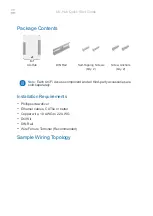
Module Operation
712
SPNU563A – March 2018
Copyright © 2018, Texas Instruments Incorporated
Direct Memory Access Controller (DMA) Module
20.2.8 Auto-Initiation
When Auto-initiation Mode (AIM) bit of Channel Control Register (
) is enabled for a
channel and the channel is triggered by a software request for a block transfer, the channel will restart
again using the same channel information stored at the respective control packet after one block transfer
is completed. In the case of Hardware Request the channel needs to be retriggered each time after a
block is complete even if auto-initiation is enabled.
20.2.9 Interrupts
Each channel can be configured to generate interrupts on several transfer conditions:
•
Frame transfer complete (FTC) interrupt: an interrupt is issued after the last element of a frame has
been transferred.
•
Last frame transfer started (LFS) interrupt: an interrupt is issued before the first element of the last
frame of a block transfer has started.
•
First half of block complete (HBC) interrupt: an interrupt is issued if more than half of the block is
transferred.
–
If the number of frames
n
is odd, then the HBC interrupt is generated at the end of the frame when
(n+1) / 2
number of frames are left in the block.
–
If the number of frames
n
is even, then the HBC interrupt is generated at the end of the frame after
n/2
number of frames are left in the block.
•
Block transfer complete (BTC) interrupt: an interrupt is issued after the last element of the last frame
has been transferred.
•
External imprecise error on read: an interrupt can be issued when a bus error (Illegal transaction with
ok response) is detected. The imprecise read error is connected to the ESM module.
•
External imprecise error on write: an interrupt can be issued when a bus error (Illegal transaction with
ok response) is detected. The imprecise write error is connected to the ESM module.
•
Memory Protection Unit error (MPU): an interrupt is issued when the DMA detects that the access falls
outside of a memory region programmed in the MPU registers of the DMA. The MPU interrupt is
connected to the ESM module.
•
Parity error (PAR): an interrupt is issued when the DMA detects a parity error when reading one of the
control packets. The PAR interrupt is connected to the ESM module.
The DMA outputs 5 interrupt lines for control packet handling, a parity interrupt and a memory protection
interrupt (
). Each type of transfer interrupt condition is grouped together. For example, all
block-transfer complete interrupts that are routed to a port are combined (ORed). The channel that caused
the interrupt is given in the corresponding interrupt channel offset register. Priority between interrupts
among the same interrupt type is resolved by a fixed priority scheme. Priority between different interrupt
types is resolved in the Vector Interrupt Manager.
explains the Frame Transfer Complete
Interrupt structure in detail.
NOTE:
Each Channel Specific interrupts in DMA module are routed towards Group A or B to
support two different CPUs individually. For devices with Single CPU or Dual CPU, where
both CPUs are running same code in delayed lock-step as safety feature:
Group A - Interrupts (FTC, LFS, HBC, and BTC) are routed to the ARM CPU.
Group B - Interrupts (FTC, LFS, HBC, and BTC) are not routed out.
User software should configure only Group A interrupts.
















































